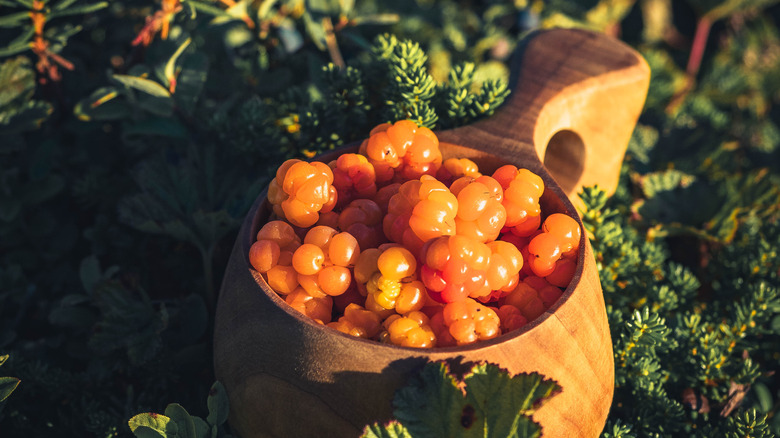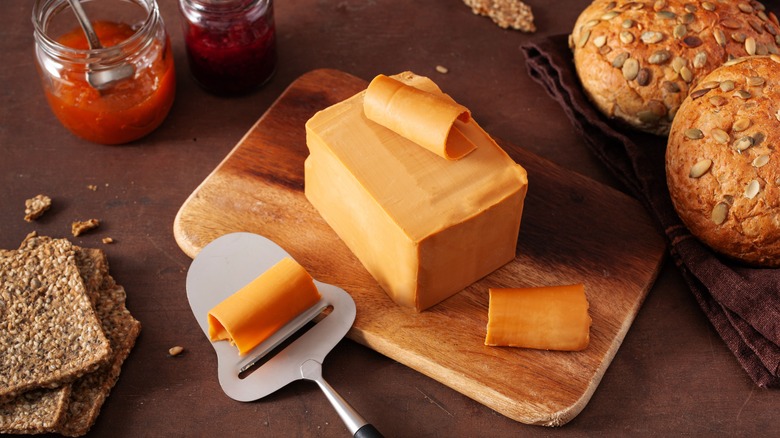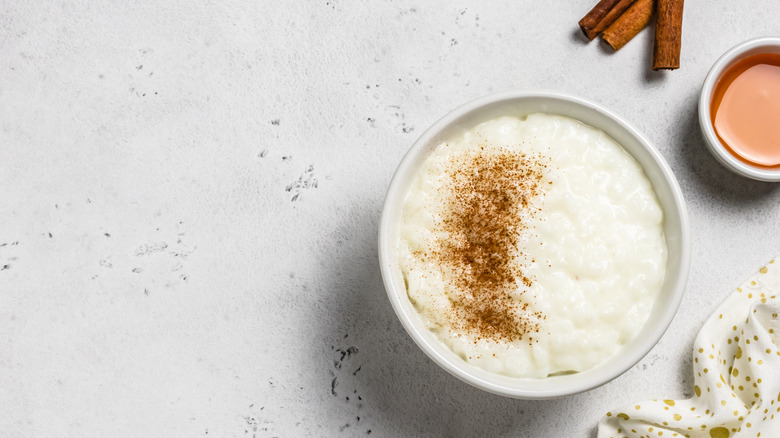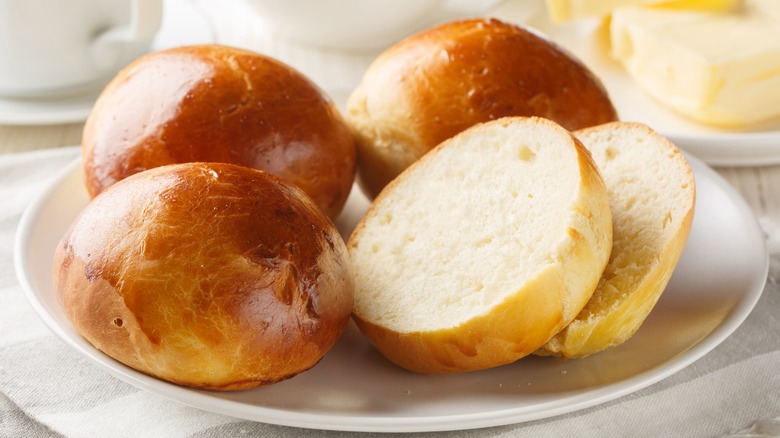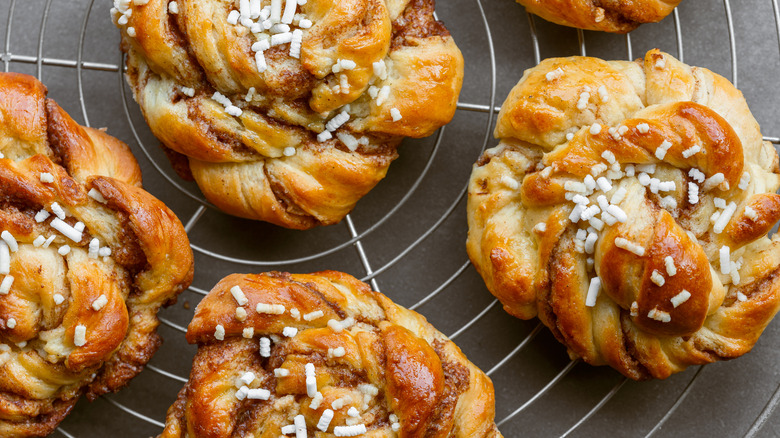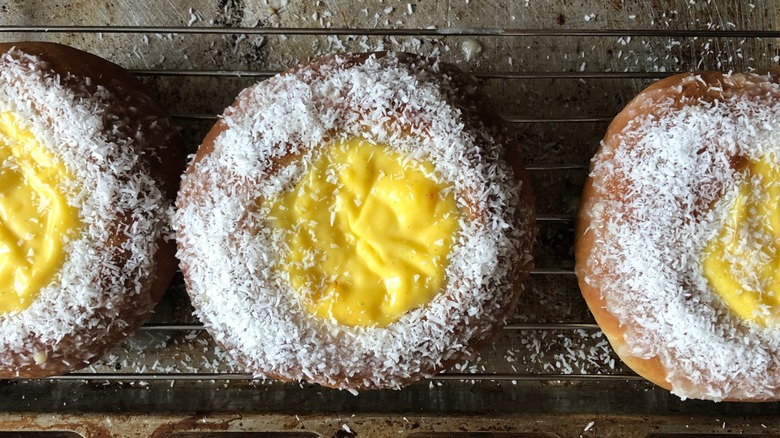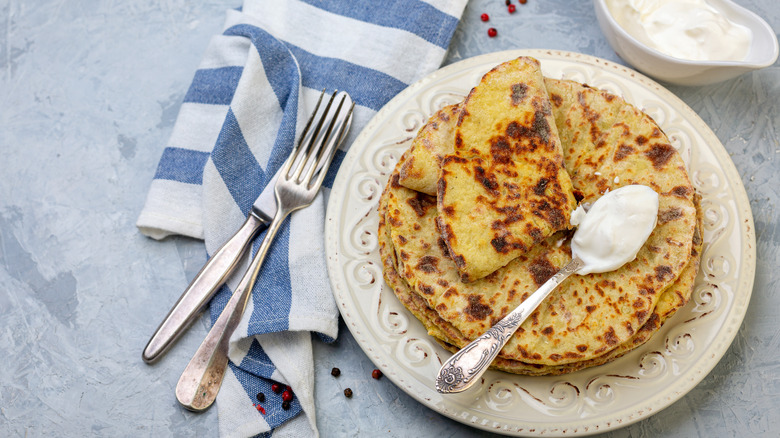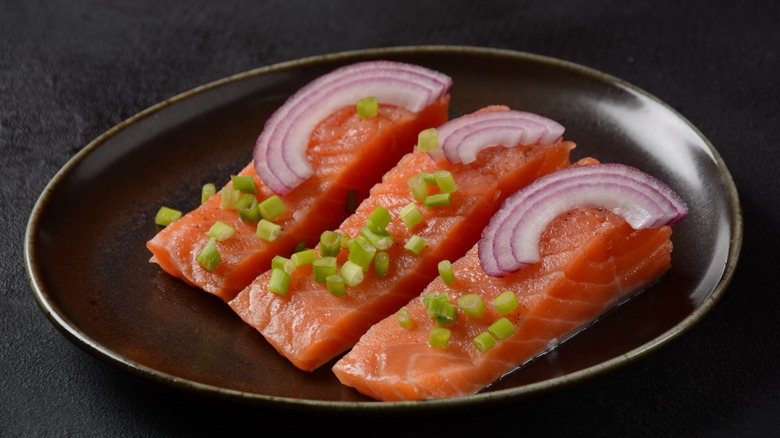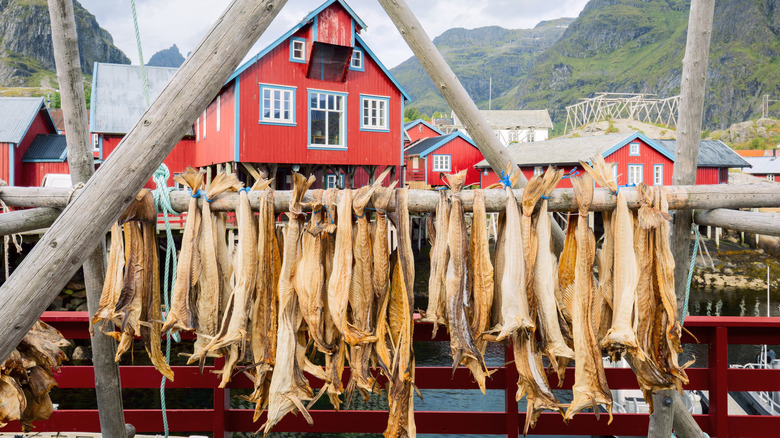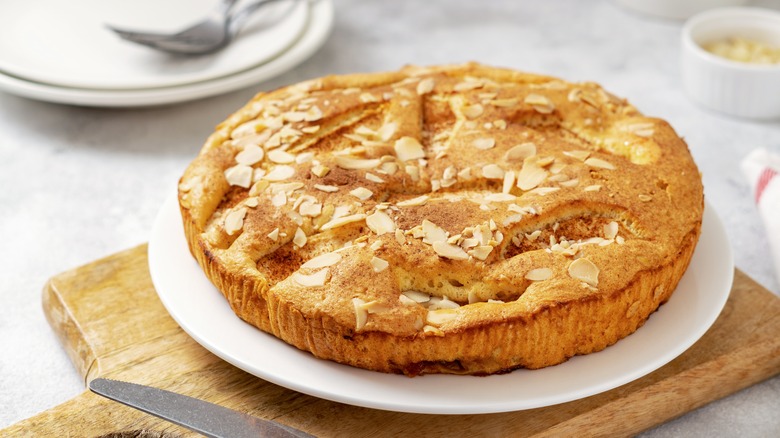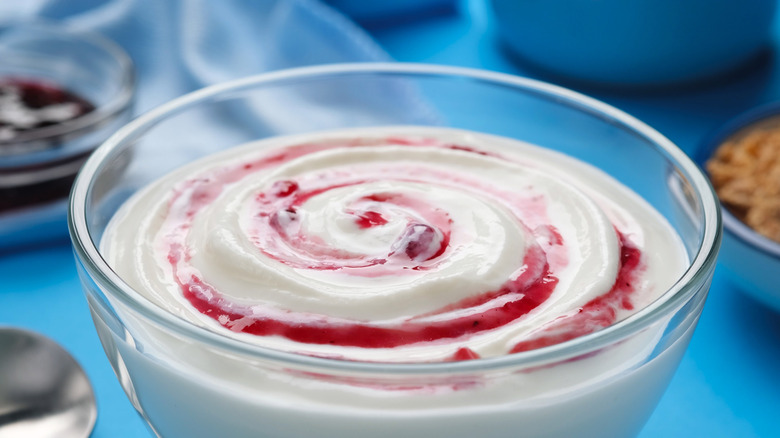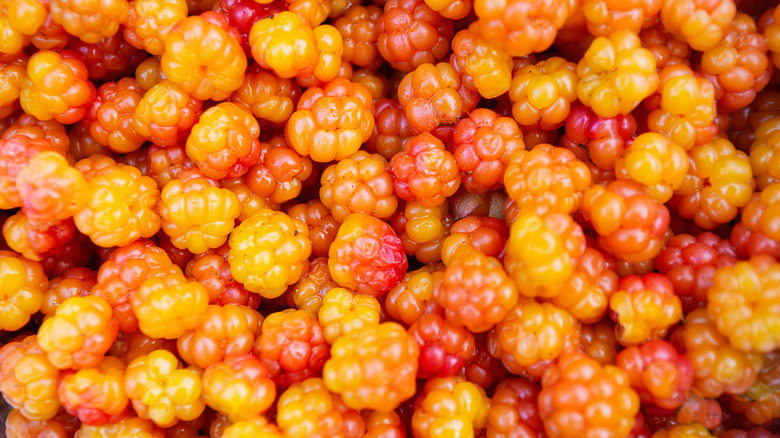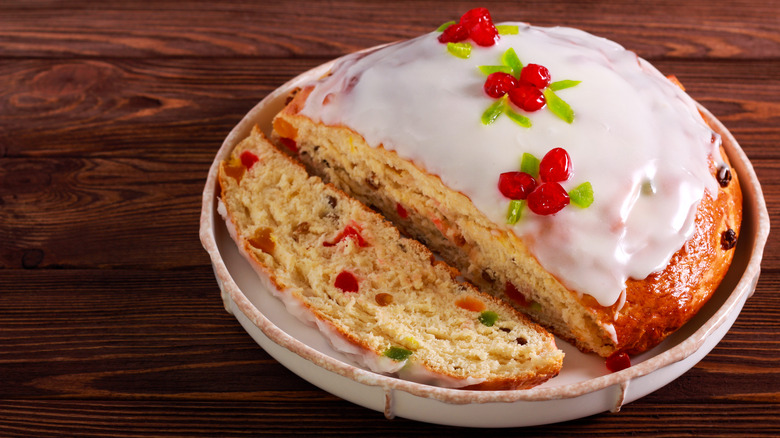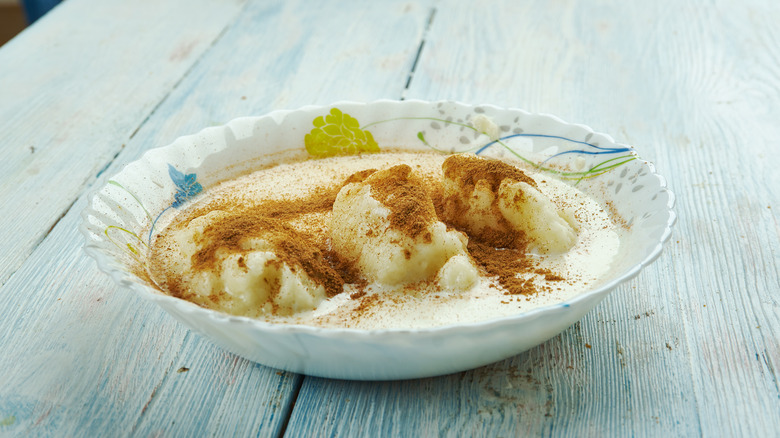Norwegian Foods You Should Try Before You Die
Some countries' cuisines are known across the globe. For instance, if you were to picture Italian food, you'd instantly think of pizza and pasta. Yet the food of other nations isn't quite as widely familiar to those outside a country's borders. Of course, that doesn't mean that cuisine is not worth exploring. In that spirit, head to Scandinavia with this list of some of the best Norwegian foods you should try before you die.
Norwegian cuisine has a lot to offer, from brunost — which is known as brown cheese, but isn't really cheese at all — to elusive cloudberries, to cinnamon buns known as kanelsnurrer. Some foods are likely different from anything you're likely to have encountered in the U.S., while others may be surprisingly familiar.
Most of these dishes are hard to find outside of Norway or Scandinavia (or Norwegian enclaves), while some are gaining worldwide popularity. Still, if you want to try these foods in their most authentic form, you'll likely have to pay for a trip to Norway or make them yourself. Whether you're planning an adventure or simply interested in another culture's cuisine, these are some of the Norwegian foods you need to try in this lifetime.
Brunost
One hugely popular food in Norway that's virtually unheard of further afield is brunost. It's sometimes referred to as brown cheese and, while it is somewhat brown in color, it isn't truly cheese. So, what is it? Brunost is actually made from whey, a byproduct of cheese production. Making it involves boiling the whey to reduce it and caramelize the sugars, which gives brunost its characteristic brown color, distinctive flavor, and smooth, dense texture. While it's softer than regular blocks of cheese, it can be sliced or grated. It's often enjoyed on bread or crackers as a popular breakfast and lunch food all over Norway. People also use it as an ingredient in recipes.
Its taste is tricky to explain without trying it yourself, but you can expect savory notes from the whey (typically derived from goat or cow's milk) as well as a sweet, caramel-like flavor. You've probably never tasted anything like it. Some consider it an acquired taste, but we think that millions of Norwegians can't be wrong.
Brunost is easy to find while visiting Norway, as you'll be able to pick it up in virtually any grocery store. Outside of Scandinavia, however, you'll have to look for brunost in specialty stores stocking imports, if you can find it at all.
Rømmegrøt
Rømmegrøt literally translates to sour cream porridge. Armed with that information, you've already got some idea of what it is. Although the porridge you're used to might be oat-based, rømmegrøt is made from a mixture of sour cream, flour, and milk. It has a distinctive flavor thanks to the tangy sour cream, which also contributes to its rich, creamy consistency. That said, families may have their own unique recipes, while some people use heavy cream instead of sour cream.
This dish is often served during celebrations or holidays. Strangely for porridge, at least to many outside of Norway, it's often considered a summer food and can have associations with midsummer festivities. It's certainly not seen as an everyday dish due to its richness.
The process of making rømmegrøt is fairly simple, as ingredients are mixed and cooked together until the porridge reaches the desired thickness, then typically seasoned with a little sugar and salt. It can be served with a variety of toppings like melted butter, cinnamon, and brown sugar. If you're making it and want some hints, if something is good with oatmeal, then it'll probably be good with rømmegrøt.
Bolle
A bolle is a type of sweet bun enriched with butter, milk, and sugar that has woven itself into the fabric of Norwegian culinary traditions. There are many types of bolle that you'll find all over the country, from artisan bakeries to grocery stores. Hveteboller are often known as plain sweet buns, but they're actually lightly flavored with cardamom. They can be eaten plain, served with butter and preserves, or regularly enjoyed with brunost.
Venturing beyond the realm of plain buns, we encounter rosinboller or raisin buns. Imagine the same pillowy dough, now adorned with plump, juicy raisins that add a delightful burst of sweetness to each bite. For those with a penchant for nuts and spices, nøtteboller are a must-try. This variant often features a luscious mixture of chopped nuts, sugar, and perhaps a hint of cardamom. There are also sjokoladeboller, which are filled with chocolate.
Whether you find yourself in the vibrant streets of Oslo, the picturesque landscapes of Bergen, or the quaint villages nestled in the fjords, you can rest assured that a delightful bolle is never far away, as Norwegian boller have become a beloved treat.
Kanelsnurrer
Bolle are generally fluffy, round buns, but kanelsnurrer are different. They might be described by people in the U.S. as a type of cinnamon bun, but kanelsnurrer are more like cinnamon twists, with thinner, intricately knotted dough filled with a generous layer of cinnamon and sugar. The dough itself is cardamom-flavored, so you get a mix of sweet, fragrant spices.
The result is a tasty knot that is reminiscent of a cinnamon roll but with a unique twist — literally. The dough itself is a crucial component, boasting a perfect balance of softness and elasticity. Shaping kanelsnurrer takes some finesse, which is why they're more commonly bought in bakeries than made at home. They're hugely popular in Norway, making regular appearances at breakfast tables, afternoon coffee gatherings, and anywhere else you might enjoy a sweet snack.
While typically Scandinavian, we're starting to see this kind of sweet bun in artisan bakeries in other parts of the world, so you might not have to go all the way to Norway to try one. Although they're still only found now and then in the U.S., we wouldn't be surprised if they're about to take off.
Skolebrød
Skolebrød — which translates to "school bread" — is a tasty sweet treat that's often enjoyed by kids, although people of all ages can partake. The enriched dough that makes up skolebrød is similar to that of a bolle. However, it's filled with vibrant vanilla custard in the center, then sprinkled with shredded coconut. What's great about skolebrød is its array of textures and flavors. As you take a bite, the interplay of the soft bun, creamy custard, and shredded coconut is a textural delight — and it tastes amazing, too.
This treat has become a staple in Norwegian bakeries, cafes, and even large supermarkets. It's also popular as a snack in school lunchboxes (hence the name), making it a nostalgic treat for many.
While skolebrød can be enjoyed at any time of the day, it is particularly associated with fikapause, the traditional Norwegian coffee break. It's hard to find outside of Norway, although there are plenty of recipes to be found online if you want to try making them for yourself.
Lefse
Lefse is a traditional Norwegian flatbread. This thin, soft bread has a rich history. In fact, it may be one of Norway's oldest traditional foods that are still enjoyed today. Lefse is typically made from a simple dough comprising flour, water, and sometimes potatoes or milk, depending on what region you're in. The dough is rolled out into a thin, flat, round disc and then cooked on a griddle or griddle pan until it develops a golden-brown hue. The result is a soft, pliable flatbread that works well in many dishes.
The versatility of lefse is one of its defining features. Traditionally, it was a staple during festive occasions and holidays, where it is often served with butter, sugar, and cinnamon for a sweet treat. Alternatively, it can be filled with savory ingredients like meats, cheeses, or spreads, in much the same way you might make a wrap out of a tortilla. Since it's Norway, many people eat lefse with brown cheese, too.
The preparation of lefse is often a familial affair, with generations coming together to roll out the dough, cook it, and share the final product. This communal aspect is part of the magic of lefse — though of course, you can also buy it in shops or cafes.
Rakfisk
Thanks in part to its estimated 63,000 miles of dramatic coastline, Norway is widely known for its fish-centric dishes. Rakfisk is a traditional Norwegian dish that consists of fermented fish, typically trout or char. All true rakfisk must be produced in Valdres in southern Norway. Its preparation involves a process where the fish is salted and then left to ferment for several weeks to months. This imparts a strong, distinct flavor to the fish and contributes to its characteristic pungent aroma.
The resulting product is often served raw, commonly with lefse, potatoes, sour cream, red onions, and sometimes mustard, allowing diners to customize the experience and balance the intense flavors. It's often accompanied by aquavit, a traditional Scandinavian spirit that is believed to complement the strong flavors of the fermented fish.
While rakfisk might not be everyone's cup of tea due to its intense taste and aroma (it's been likened to old cheese and dirty socks) it remains a symbol of Norway's cultural heritage and culinary tradition. For those with real culinary curiosity, trying rakfisk can be a memorable adventure into traditional Nordic cuisine. You're likely to find it in any restaurant that specializes in typical Norwegian food.
Tørrfisk
Tørrfisk, translating to "stockfish," is a traditional Norwegian food that's linked to a particular method of preserving fish, primarily cod. This ancient technique involves drying fish in the open air without using salt, making it an important element in the culinary history of Nordic countries.
The process of making tørrfisk is straightforward yet requires careful attention to detail. Fresh fish is cleaned and split before being left to dry on wooden racks, typically outdoors. The cold, dry Nordic air plays a crucial role in this preservation method, as the fish slowly dehydrates while retaining its nutritional value. The result is a firm, lightweight product that can be stored for an extended period without refrigeration. Tørrfisk has been a staple in Norwegian cuisine for centuries, serving as a reliable source of protein when fresh fish grew scarce, especially during the winter months.
Tørrfisk is versatile, but the best way to enjoy it is rehydrated and cooked in various dishes when its flavor is considered better. One popular preparation involves soaking the stockfish in water, and then incorporating it into stews, soups, or casseroles. The reconstituted fish maintains a mild, delicate taste while absorbing the flavors of the surrounding ingredients.
Eplepai
As you might guess if you try to say it out loud, eplepai means apple pie in Norwegian. But, in this delightful dessert, chunks of apples are stirred into a stiff batter, creating a delectable treat that leans towards the cake rather than a classic American-style pie.
To prepare eplepai, you simply cut apples into chunks — although some recipes call for thinner slices — before stirring them into a batter. The batter in question is typically made from a blend of flour, butter, sugar, and other ingredients typical to cake. It's also flavored with spices such as cinnamon and cardamom. Many cooks also reach for sliced almonds, which they stir into the batter alongside the apples or arrange on top.
Unlike pies that come with a flaky crust, eplepai embraces a thicker, more cake-like consistency. The result is a rich and moist dessert that encapsulates the sweet and spiced essence of baked apples. The apples become tender during the baking process, infusing the cake with their natural flavors. While you might find eplepai in some Norwegian bakeries year-round, it's especially popular in the fall when apples are in season.
Trollkrem
Trollkrem translates to troll cream in English, but don't be put off by the name. Despite its playful moniker, trollkrem is not really a cream but a lingonberry mousse. It is extremely light and can be eaten alone or as a topping for other desserts. This traditional Norwegian dessert is as whimsical in name as it is delightful in taste.
To make trollkrem, whip egg whites to stiff peaks before stirring in lingonberry jam. Some recipes call for sugar to join the egg whites, while others leave out the sugar and rely on jam for sweetness. You can also use aquafaba — the liquid that surrounds cooked chickpeas – to make a vegan version.
Sometimes, vanilla extract or vanilla sugar is added to enhance the flavor of trollkrem, imparting a subtle sweetness and fragrance to the airy creation. While its ingredients may make it seem simple, the key to crafting a successful trollkrem lies in achieving the perfect texture — a delicate balance between lightness and stability. Trollkrem pairs wonderfully with fresh berries, fruit compotes, and simple cakes. Of course, you can always eat it on its own as a sweet, cloud-like treat.
Cloudberries
Cloudberries, often known as multe in Norwegian, are small, golden-orange berries that grow in the Arctic and subarctic regions of the Northern Hemisphere. These berries belong to the rose family and are prized for their distinctive sweet and tart taste. Cloudberries are particularly popular in Norway, where they hold cultural significance and are celebrated for their versatility.
Cloudberries thrive in very specific regions, including the high-altitude marshes found in Norway. The limited growing conditions contribute to their rarity and desirability. Harvesting cloudberries is a cherished tradition in Norway, and many families take part in foraging for them during the short summer season. The act of picking cloudberries has become a social activity, and the berries are often shared among friends and family. You can also buy them at markets, but they can be expensive.
Cloudberries are used in a variety of culinary preparations in Norway. They can be enjoyed fresh, made into jams, preserves, or sauces, and are often used as a topping for desserts like cakes and puddings. The versatility of cloudberries allows them to be incorporated into both sweet and savory dishes. Due to their limited availability, cloudberries are considered a delicacy in Norway. Whether enjoyed fresh in the wild or incorporated into a dish, these golden berries hold a special place in the hearts of Norwegians and are a symbol of the country's natural bounty.
Julebrød
If you're looking for something delicious and festive, you need to check out julebrød (known as Christmas bread in English). This traditional bread is enjoyed in Norway during the Christmas season and is enriched with a variety of ingredients that give it a rich and flavorful profile. It's sometimes also called julekake because its texture lands somewhere between bread and cake.
It's often studded with a mix of dried fruits, such as raisins, currants, and candied citrus peels. These add sweetness and a burst of fruity flavor to the bread. Warm spices like cinnamon and cardamom are frequently used in julebrød, infusing the bread with a festive aroma and flavor. It also typically contains butter and milk, both of which contribute to its rich taste, as well as its soft and moist texture.
Some variations of julebrød may be adorned with a glaze made from powdered sugar and citrus juice, adding a sweet and tangy finish. Julebrød is often shaped into a loaf, but it can also be formed into wreaths or braided for a more decorative presentation. The bread is enjoyed throughout the holiday season when it's often served sliced with butter or brunost.
Raspeball
A raspeball — also known as klubb, komle, or raspeboller in different regions of Norway — is a hearty potato dumpling. Though the specifics can vary from region to region, the main ingredients in raspeball are potatoes alongside barley or oat flour, both of which come together to create a dense and filling dumpling. The potatoes are typically grated or ground to a fine consistency, which are then combined with flour to form a dough. The dough is then shaped into round dumplings which are boiled until they are cooked through.
Raspeball is often served with a variety of accompaniments that enhance its flavor and texture. These include a rich meat-based sauce, as well as kjøttkaker (Norwegian meatballs), cured meats, or bacon. People also serve these dumplings with melted butter, lingonberry sauce, or a drizzle of syrup, again depending on regional differences and personal preference.
The dish has deep roots in Norwegian culinary traditions and is particularly associated with rural and coastal areas of the country. Despite their simplicity, raspeball dumplings are an important and notable part of Norway's food heritage.
